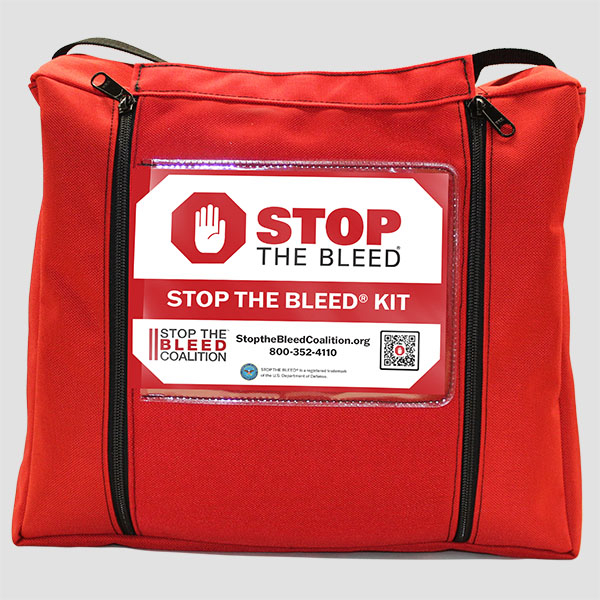Bleeding kits are essential tools used in emergency situations to control bleeding and provide first aid. They typically contain items like:
Dressing and Bandages: Sterile gauze pads, trauma dressings, and elastic bandages for applying pressure.
Tourniquets: Devices designed to apply pressure to a limb to control severe bleeding.
Antiseptic Wipes: For cleaning the area around a wound to reduce the risk of infection.
Medical Tape: To secure dressings in place.
Gloves: Disposable gloves to protect both the responder and the victim.
Scissors: To cut clothing or dressings as needed.
Instructions: Guidelines for proper use of the kit and how to manage bleeding.
It's important for individuals and organizations to keep these kits well-stocked and easily accessible, especially in environments where injuries are more likely to occur, such as workplaces, schools, or outdoor activities. Regularly check expiration dates and restock items as needed. Would you like to know more about specific components or how to use them?

1. AED Device
The main defibrillator unit, which is designed to analyze heart rhythms and deliver an electric shock if necessary.
2. Adult and Pediatric Pads
Electrodes that attach to the patient’s chest. Many AEDs come with both adult and pediatric pads, or pads that can be used for both.
3. User Instructions
Clear, step-by-step instructions for operating the AED, often available in multiple languages. Some cabinets also include visual guides.
4. CPR Mask
A barrier device to provide rescue breaths safely during CPR.
5. Gloves
Disposable latex or nitrile gloves to protect the responder during a medical emergency.
6. Scissors
For cutting clothing to access the chest if necessary.
7. Alcohol Wipes
For cleaning the area where the pads will be placed, ensuring good adhesion.
8. Emergency Contact Information
Instructions on who to contact for emergency services and internal emergency protocols.
9. Signage
Clear signs indicating the location of the cabinet and instructions for use, often featuring bright colors for visibility.
10. Battery and Maintenance Log
Some cabinets include a log to track the maintenance and checks of the AED, including battery replacement and pad expiration dates.
Considerations for Installation:
Accessibility: Ensure the cabinet is easily accessible to both staff and guests.
Visibility: Use bright colors and clear signage to mark the location of the AED cabinet.
Regular Checks: Implement a routine for checking the contents of the cabinet to ensure everything is stocked and functional
Installing an AED (Automated External Defibrillator) in a small business can significantly enhance workplace safety. Here are some key considerations and benefits for small businesses:
Benefits of Having an AED
Life-Saving Potential: AEDs can dramatically increase survival rates for cardiac arrest victims. Quick access is crucial for effective intervention.
Employee Safety: Providing an AED demonstrates a commitment to employee health and safety, fostering a supportive work environment.
Guest and Customer Care: If your business serves the public, having an AED can enhance customer safety and confidence.
Regulatory Compliance: Depending on your location, there may be legal requirements for AEDs in certain types of businesses, particularly those with larger foot traffic.
Emergency Preparedness: An AED is a key component of a comprehensive emergency response plan, ensuring you’re ready for medical emergencies.
Training Opportunities: Installing an AED encourages staff training in CPR and AED use, promoting a culture of safety.
Improved Reputation: Businesses that prioritize safety can enhance their reputation, attracting more customers and employees who value a safe environment.
Key Considerations for Implementation
Choosing the Right AED:
Look for user-friendly models that provide clear audio and visual instructions.
Consider features like adult and pediatric pads, long battery life, and durability.
Location:
Place the AED in a visible and accessible location, ideally near high-traffic areas or where large gatherings occur.
Training:
Provide training for employees on how to use the AED and perform CPR. Consider regular refresher courses.
Maintenance:
Implement a routine for checking the AED to ensure it’s operational, including battery checks and pad expiration dates.
Emergency Protocols:
Develop clear emergency response protocols and ensure all staff are familiar with them, including how to call emergency services.
Signage:
Use clear signage to indicate the location of the AED and provide simple usage instructions.
Budgeting:
Factor in the cost of the AED, ongoing maintenance, and training when budgeting for the installation.
Additional Tips
Engage with Local EMS: Inform your local emergency medical services about your AED installation so they can assist in training and know its location.
Encourage a Safety Culture: Promote awareness about the importance of having an AED and emergency response readiness among employees.
By installing an AED, small businesses can enhance their safety measures, potentially saving lives in critical situations. If you need further assistance or specific product recommendations, feel free to ask!






